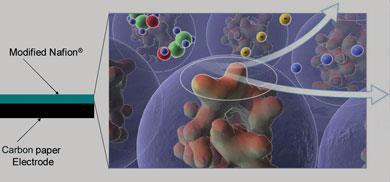Mobile phones could run on glycerol
Mobile phones could run on glycerol, report US researchers.
Fuel cells - potential battery replacements - traditionally use oxidising platinum catalysts to generate a flow of electrons from molecules like hydrogen or methanol. But such catalysts are expensive and can produce toxic byproducts (formaldehyde, in methanol’s case), said Shelley Minteer of St Louis University, Missouri.
Minteer’s group is one of many investigating a cheaper option: extracting enzymes from living cells to chew up the fuel, via biochemical pathways. While bacterial enzymes are kinder to the environment than platinum, producing only carbon dioxide and water or non-toxic metabolites like pyruvate, they are also more fragile, and work in a much narrower temperature range.

Minteer’s group have already developed membranes for immobilising enzymes in buffered solution - ’a kind of straitjacket’, as Minteer puts it - so that they keep working for months or years.
Now they are considering which fuel combines best with their new system. Microbial fuel cells can eat anything from ethanol to glucose, but Minteer and graduate student Rob Arechederra suggest glycerol as the discerning chemist’s choice. Stores of the sugar alcohol are rapidly piling up, since it is the byproduct of biodiesel formation - amounting to some 10 per cent of diesel produced. And it packs in high energy density, while also being non-volatile and non-toxic.
Past attempts to extract electricity from glycerol with fuel cells had produced disappointing results, because it combines poorly with traditional platinum catalysts, said Minteer, who presented her work on microbial fuel cells at the American Chemical Society’s spring conference in Chicago.
Not so with her group’s alcohol and aldehyde dehydrogenase enzymes, extracted from the bacteria Gluconobacter. The enzymes are immobilised in the pores of a commercial ion exchange copolymer membrane, Nafion, already used in fuel cells. The membrane had to be modified with quaternary ammonium bromide groups, to expand its pores and make the environment more hydrophobic and enzyme friendly.
Armed with these glycerol fuel cells, Minteer’s student Arechederra says he’s achieved early maximum power outputs of around 70mW per square centimetre of membrane, enough in principle to run a small mobile phone, which requires 100-300mW. There’s no chance of running something like a car battery - best left to commercial solid oxide fuel cells which run at high temperatures - but the team has licensed their technology to a small St Louis startup company. Minteer estimates it will take about 3-5 years before glycerol clips could be used to power mobile phones or iPods. The key to commercial development will be improving the enzymes’ lifetime and performance at varying temperatures, she said.
The St Louis scientists are also testing other sugar-chewing fuel cells, presenting one at the ACS meeting that was entirely biodegradable; even the membrane was derived from polysaccharides. But glycerol seems most promising from the cost perspective, said Minteer.
Bruce Logan, of Pennsylvania State University, warned that the cost of microbial fuel cells might restrict their immediate use to niche applications. He advocates using them to chew up contaminants in wastewater while simultaneously producing electricity; Adam Heller’s team at the University of Texas are adapting miniature biofuel cells to make implantable medical sensors, which could act as pacemakers, taking in the body’s glucose as fuel.
Richard Van Noorden






No comments yet